印度乐施会 2022 年的研究显示,印度媒体十分之九的领导职位均由高种姓成员佔据;没有一个达利特(印度最低种姓的社群)或阿迪瓦西社群(Adivasi,印度原住民)在主流媒体中佔据最高地位。
为印度中部原住民创建的公民记者平台 CGNet Swara 的创办人 Shubhranshu Choudhary 说:“我们的大众传播并不民主。我认为它更加精英化、由上而下且缺乏共融性。”
缺乏多元社群代表性会严重影响新闻机构的新闻採集与呈现。对于印度原住民社群来说,这后果不仅仅是他们的叙述被忽视或歪曲,他们连造访媒体平台的内容也受到限制。
“无论是食物、文化还是传统,主流媒体都会从他们自己的角度去重新解读这些故事,” Adivasi Lives Matter 的项目经理 Nitesh K. Mahto 说。此平台旨在指导和赋权 Adivasi 年轻人去分享自己的故事。“这是因为主流媒体中原住民声音很少;这情况在部落故事中已持续了很长时间。”
由于母语内容稀缺,原住民社群长期以来一直依赖口述传统,这使他们孤立无援,其担忧也无人知晓。为了改变这一现状,CGNet Swara 正在帮助这些社群成为自己的故事叙述者——报道对他们来说重要的问题,并分享他们的观点。
社群成员记者育成计划
Choudhary 在印度中部的恰蒂斯加尔邦(Chhattisgarh)长大,这是一个毛派武装分子与政府安全部队之间的冲突持续了已数十年的地区。当地印度原住民社群无奈被捲入双方交战之中,承受着暴力和不稳定的沉重代价。
Choudhary 最初认为这是国家与武装叛乱分子之间的战斗,后来他明白这根源于更深层的沟通失败。他于 2010 年创立了 CGNet Swara,旨在扩大来自印度部落主要聚居地带(包括恰蒂斯加尔邦)的人民的声音;这些地区恰恰也是印度公共服务最匮乏的地区。
他说:“叛乱是由两个群体推动的:1% 是了解毛主义意识型态的领袖,而另外 99% 是普通民众,他们因自觉被忽视而诉诸暴力。我的目标是创造一个平台,让他们的声音得以表达。”
CGNet Swara 团队培训公民记者在冈瓦纳(Gondwana)中部地区(包括恰蒂斯加尔邦、中央邦和贾坎德邦)透过手机製作音频新闻报道。这平台报道土地权利和森林侵佔、公共基础设施和食水的缺乏;也有发布有关当地的歌曲和诗歌。
“故事就是对人来说重要的一切;它可以是任何 [原住民] 认为重要到足以告诉别人的事情,” Choudhary 说。
善用科技
由于意识到行动装置的日益普及,CGNet Swara 发掘了利用手机进行报道的机会。团队在试验互动式语音应答技术时发现,即使在受左翼极端主义影响、没有讯号的地区,智能手机仍被广泛使用。
CGNet Swar 让用户能拨打电话并报道或收听其他呼叫者提交的新闻消息。团队亦将音频剪辑上传到伺服器上,再由训练有素的记者在伺服器上审阅和查核录音。经批准的信息可以透过电话和网站上播放,在播出时,这些内容已经过事实查核、翻译并辅以简短的文字发布。
“我们称那些从偏远地区向我们发送报道的记者为 ‘Bolkars’,” CGNet Swara 执行主编 Diptendu Roy 说道。“而被称为 ‘Jodkars’ 的编辑们则进行审阅以及必要的编辑,确保故事在我们的平台上发布之前符合新闻标准。”
Roy 回忆起 COVID-19 期间的一件事:平台的一些部落记者被困在东戈达瓦里地区(East Godavari)的一个村庄,当时他们向 CGNet Swara 寻求帮助,并传播他们的困境。CGNet 的一名志工在推特上发布了相关消息,一小时内,地方法官迅即作出了回应并解决了这个问题。
“我们不提供食物或住所;我们所做的只是创建一个平台并充当桥樑。对于城市里的人们来说,这可能看起来很小或微不足道,但想像一下在封城期间被困在一个偏僻的地方,” Roy 说。“对于那些处于这情况的人来说,这意味着一切。”
资金障碍
缺乏资金仍然是 CGNet Swara 面临的主要挑战。这令团队的行销和发行大大受限,难以宣传自己并吸引更多受众,包括那些将从其报道中受益最多的人。
儘管对于如何运作下去有明确的路线图,但团队仍难以获得支援和扩大业务所需的资源。
Mahto 说:“我们能够运营是因为来自各个机构的资助,这使我们能够支持新手叙事者。但财政挑战仍然存在;我们总是需要额外的资金和捐款来维持我们的工作。付款延迟和筹集捐款的困难仍是我们不断面临的问题。”
图片来源:ASHUTOSH CHAUDHARI on Unsplash.

